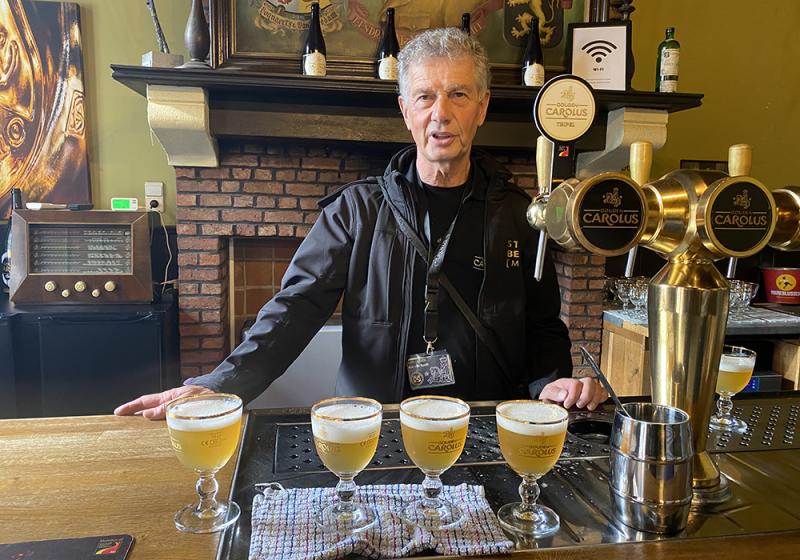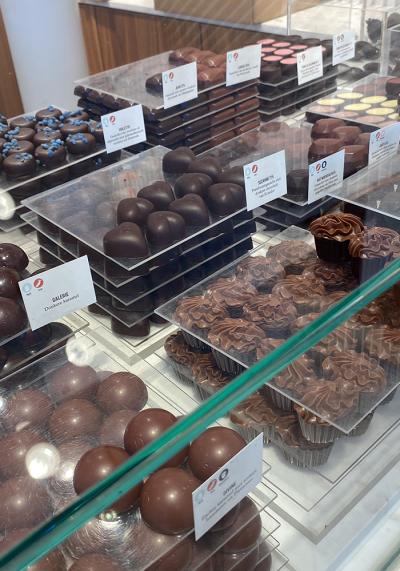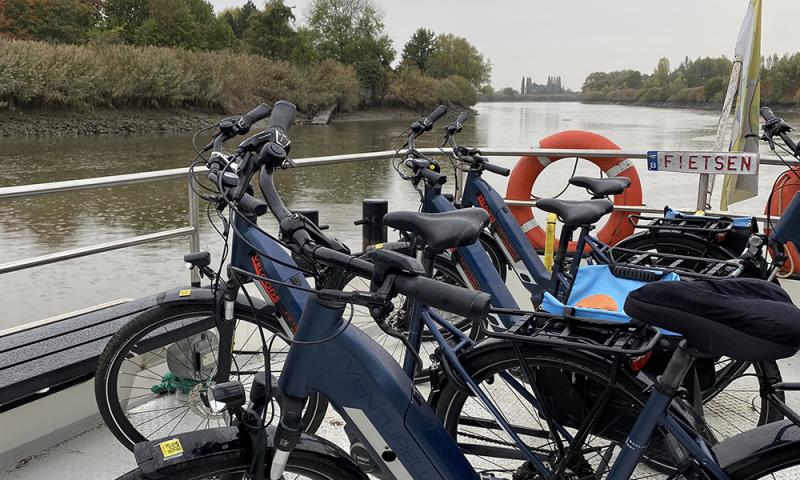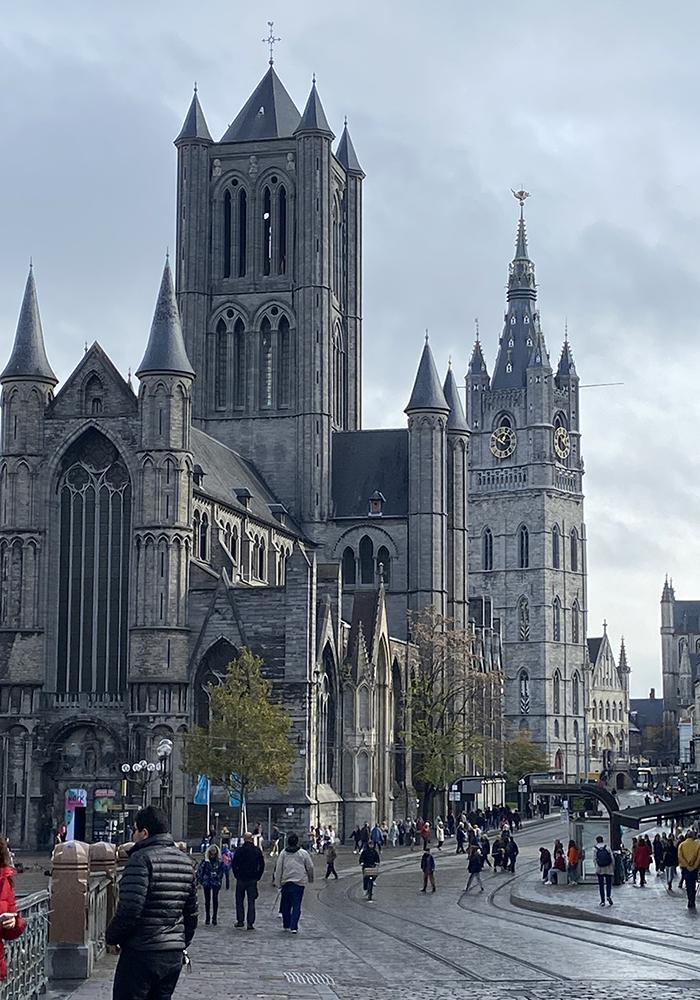Looking for a holiday that checks all the boxes—charming historic cities, delicious food, breathtaking countryside, is eco-friendly and you’re exercising? Oh, and by the way, it keeps your teen off the screens for a good portion of the day. This is not a fantasy. It is Flanders by Bike.
Flanders, the Dutch-speaking part of Belgium, is also one of the most popular cycling regions in Europe. Why? Because Flanders has pioneered a system of “cycling nodes,” clearly marked and impeccably maintained bike routes with signposts and distance information. The country now has over 12,000 kilometers (about 7,500 miles) of signposted cycle trails, which have been further organized into nine iconic routes by Flanders by Bike for different interests and fitness levels. Even better, the routes are synched up with Google Maps, so you can download the plan to your phone and go!
At the suggestion of Visit Flanders, we did the “Art Cities” route, which connects Brussels, Leuven, Mechelen, Antwerp, Ghent and Bruges, through to the coast at Ostend, over 342 kilometers (about 212 miles) of trails. You can choose which city you start or end from, and modify the trail to suit your time frame. Due to only having five days, we cut out Brussels, Leuven and Ostend, but my 16-year-old son and I had so much fun, we are already planning to go back to see what we missed. Here are the highlights of our trip:
First stop: Mechelen
Only a 20-minute train ride from Brussels, Mechelen is perfect for Day 1 as it is a walkable city with a large open central market square surrounded by charming historic buildings. Once the capital of Belgium, Mechelen has around 300 protected monuments, many of which are UNESCO World Heritage Sites, including the not-to-be-missed St. Rumbold's Cathedral. The construction of this cathedral began in the 13th century and lasted until the beginning of the 16th century, it has an impressive interior that includes fascinating works by artists such as Van Dyck, Michel Coxcie, and Gaspard de Crayer. Tip: Climb to the top of the tower up 538 steps in the spire up 318 feet, for 360-degree views over the city.

Climbing will make you thirsty. Ideal since Mechelen is home to the Het Anker brewery, creators of the most delicious beer in the world, the Gouden Carolus Tripel, which they have been brewing since 1491. We learned how they make it on a short tour of the brewery, which finishes with a tasting. Served cold, it is unbelievably refreshing. Fun fact: The drinking age in Belgium is 16—perfect for my son! The brewery has 22 hotel rooms, which are funky with beer-themed decor. Where to eat: The new Emiel restaurant in the Fish Market area offers set menus featuring local seafood. The verdiect? Michelin-star quality food, but the place was too new to have one.
Though it has a lot of history, Mechelen isn’t caught in the past. The Financial Times named Mechelen as one of the 10 European cities of the future; the mayor has been active in attracting immigrants and is proud that 180 different nationalities are represented in the city. Good to know: There is an interactive science museum and a new library built in a monastery from the 1600s rated one of the top five in the world.
Our bikes were delivered to the Het Anker by VOS Travel, which has been specializing in cycling tours since 1987. To make it more fun, and easier to cover long distances, we used e-bikes. You still have to pedal, but the bike has a battery with four modes ranging from “eco” to “turbo,” giving you a boost to go a bit farther and faster. The bikes are very comfortable and stable, but heavier than normal bikes. VOS provides helmets, a fix-it kit if you get a flat, a lock system, and a pannier bag for snacks and water. Also, they transport your luggage from hotel to hotel, so you have nothing to worry about.
Mechelen to Antwerp
We set off after breakfast to cycle to Antwerp, the route is about 30 miles, mainly along canals and through the stunning countryside much of it on the cycling “Super Highway;” this is a dedicated two-lane road just for bikes! E-bikes are allowed and it all feels very safe as there are no cars. My son liked to put his bike in “turbo” and let it rip. I preferred “eco” and a more leisurely pace. The cycle roads are beautifully maintained and along the way we saw several workmen trimming the foliage and keeping the roads in top shape. Directions are well marked.

We made it to Antwerp for lunch, in a newly, but sensitively reclaimed area called Pakt, where they’ve turned formerly abandoned warehouses and an old military hospital into a lively live-and-work neighborhood that incorporates entrepreneurs, artists and urban farmers, creating a circular economy. Think: Lots of historic brick buildings with edgy modern interiors surrounding green courtyards, and rooftop gardens—it’s stunning. We enjoyed pizza and beer outside at Standard Pizza, all farm-to-table ingredients.
With a history dating back to the Middle Ages, Antwerp is a port city, still one of the biggest in the world and the second largest in Europe, most famous for the diamond trade. But we shifted our focus to another jewel of Belgium—chocolate—and ventured to Chocolate Nation, an interactive chocolate museum where you can sample 14 varieties at the end. Located across from Antwerp’s Central Station, a Belle Epoch-era building considered one of the most beautiful train stations in the world.
As we were on the Art Cities tour, it is worth noting that Antwerp has lots of interesting street art, but the big news is the recent reopening of the Royal Museum of Fine Art, bringing the Flemish masters back to the people after 11 years of closure for refurbishment. You’ll find classical art by Rubens and Jan van Eyck alongside more modern works—the redesigned galleries arranged thematically rather than chronologically—plus a new wing devoted to the Ostend-born artist James Ensor, and a new café.
We stayed at Yust, which opened in 2019, a conversion of the building that housed the city’s telephone and electrical works, creating a community and a hotel. The “bleisure” vibe is on point, the lobby doubles as a co-working space and the rooms range from dorms to deluxe suites and long-term rentals. They have ample bike storage in the back, and free yoga in the mornings, which I tried while my son slept. Where to eat: For Michelin-star, in the Old Town, Fiera, located in the beautifully restored stock exchange building; for late-night drinks, Dogma Cocktail Bar, with a laid-back speakeasy feel, regularly named to the “Top 50 Bars” in the world (get the Bloody Mary).
Antwerp to Dendermonde

Off again in the morning to Dendermonde, about 26 miles from Antwerp. We loved cycling through the neighborhoods on the outskirts of Antwerp and seeing the beautiful homes, as we cycled away from the city there was countryside and more canals, some we even crossed by a short (and free) ferry. We stopped for lunch at a quaint spot, Pachtgoedhof, which is literally on a farm with views of sheep frolicking in the meadows. We enjoyed rustic food and hit the road again to overnight at a modern B&B, Abalona, run by a lovely couple who built the 13-room property over the last seven years. Homey, yet sleek. Dinner was at Fleems, another Michelin-worthy restaurant that is too new; we had a five-course menu featuring seafood, pigeon and rabbit—all really delicious and creative. That said, Dendermonde was a pit stop for us on the way to Ghent.
Dendermonde to Ghent
This was our first day with a little rain, but we pedaled on and made it to Ghent in a few hours, by the time we arrived the sun was shining. Here we had my son’s favorite lunch, at the newly redeveloped Dok Noord area, another former industrial zone put to new purpose with a trendy brewery, restaurants, offices, apartments and an eco-conscious supermarket. We ate at Dok Brewing Company, where they serve about 20 varieties of limited edition beer—they keep making new recipes and once it’s gone, it’s gone. Food choices were either Italian or barbecue (which we opted for); my son had pulled pork and I had a fantastic burger…and fries. Did I mention they invented fries in Belgium? Delicious, and served with a creamy mayonnaise-type sauce. Good thing we are biking everywhere.

After lunch, we headed to our hotel, the chic 92-room Yalo, which opened in 2021. The centerpiece of the hotel is a large sunlit atrium with an uber-modern bar and restaurant, which was completely buzzing with guests in town for the Belgian Film Festival. Following a quick change, we had the afternoon to see the city. Ghent is very walkable with everything in easy reach. We loved the Castle of the Counts, with its humorous audio-guided tour recounting the building’s history dating from 1180. Saint Bavo's Cathedral is a must for fans of the 2014 movie, “The Monuments Men,” starring George Clooney, Matt Damon and Cate Blanchett, in a search for masterpieces stolen by the Nazis during WWII. Van Eyck's "Ghent Altarpiece" plays an important role in the film and you can see it up close. A great way to get a feel for the city is on a boat ride through the canal, all included in the Ghent City Card. Ghent also has lots of interesting shopping—Belgian and Scandi brands that you don’t see elsewhere. Don’t miss the eco-collections at Juttu Brands and Friends; also buy some chocolates that are so pretty they look like art (Daskalidès, Chocolatier Deduytschaever and Hilde Devolder were favorites).
Final Pass: Ghent to Bruges
This last stretch, about 30 miles from Ghent to Bruges, was some of the most beautiful cycling, through serene forests with the final approach into Bruges along a pretty tree-lined canal. A city etched in my mind from the 2008 movie “In Bruges” with Colin Farrell; it lived up to its cinematic build-up. Just walking the cobbled streets here is a pleasure, seeing the historic Markt, the Basilica of the Holy Blood and taking a boat ride through the canals. It is a stunning city.
We’re foodies, so there were three boxes left to tick: Eating “Frietkot” Belgian fries from a food cart, trying some Belgian waffles (delish from Otto Waffle Atelier) and having a Michelin-star dinner. Fun fact: Belgium has more Michelin-star restaurants per capita than any other country in the world. On our final night, we went for it, dining at the Michelin-starred L.E.S.S., which stands for "Love, Eat, Share, Smile." The modern restaurant is minimalist yet warm, the food and the decor give Asian vibes but the ingredients are local, following the “LESS” ethos. A perfect ending to a great trip.
Good to know: We were on an abbreviated trip suggested by Visit Flanders and focused on the Art Cities cycling route. Recommendation: Spend at least two nights in Antwerp and Ghent. We easily could have filled another day or two in both of those cities. Also, we missed Leuven and Ostend, which we plan to go back to see.
For questions or more information, travel advisors should contact Marco Frank, trade and partnerships manager, Visit Flanders, [email protected].
Related Articles
The Royal Museum of Antwerp, Belgium Reopens